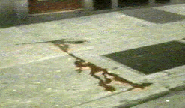


Police said that the gun which killed Faulkner was Abu-Jamal's .38-caliber Charter Arms revolver, but the defense claims that police did not do a sufficient job of proving it.
A Philadelphia medical examiner's preliminary autopsy report dated the night of the shooting indicated that Faulkner was shot by a .44-caliber. But police claimed their own ballistics tests showed the bullet taken from Faulkner's body "was consistent" with a .38--but too fragmented for a definitive finding.
Ballistics expert George Fassnacht, who testified for the defense, reviewed police records and testimony and found that there wasn't enough gunshot residue on Faulkner's back to jibe with the prosecution's contention that the shot was fired from 12 inches away.
Fassnacht also said that the prosecution's lab report was incomplete. He pointed out that police did not smell the barrel of Abu-Jamal's .38-caliber revolver, for example, to see if it had been fired, nor did they check Abu-Jamal hands to see if they bore evidence that he had fired a gun that night.
A second defense expert, John Hayes, an assistant medical examiner for the City of New York, said in his defense affidavit that there was no evidence to confirm the prosecution theory that Faulkner shot Abu-Jamal while he was standing over the officer. The downward angle of the bullet that struck Abu-Jamal could not possibly have come from someone lying on the ground.
Hayes concluded that Abu-Jamal was either prone or bent at the waist when he was shot.
Scene of the CrimeChronologyDefense Motion